|
|
 |
|
|
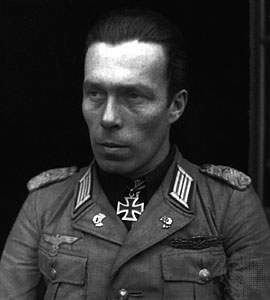 |
Major Hans von Luck
By Erik Mozolik
Hans-Ulrich von Luck und Witten was born into a family with a long military history, including service with Frederick the Great in the Eighteenth Century. Von Luck joined the German Army in 1929 and was quickly appointed to the newly-created Panzerwaffe, or Armoured Force.
Hans von Luck began 1942 transitioning from the Eastern Front just outside Moscow with the 7. Panzerdivision, to the African Front with the 21. Panzerdivision. His presence came at the personal request of General Rommel, commander of the Afrikakorps, and his old divisional commander during the battle for France. He left the front lines in late January to make the long, arduous journey back to Berlin. From Berlin, von Luck travelled to Rome via train and flew to Crete, which the Fallschirmjäger had taken the year before.
|
|
The last leg of the trip to Derna was made in a Junker 52 transport plane. It wasn’t until the first week of April 1942 that von Luck first saw the African desert. Von Luck was rushed to headquarters where he held a brief discussion with General Rommel and was debriefed by his Chief of Staff, General Gause. After being brought up to speed about the African campaign, he immediately travelled to his troops of the 3rd Panzer Reconnaissance Battalion. His direct orders were given by the divisional commander. For the time being, the battalion was charged with reconnaissance and security of the southern flank.
|
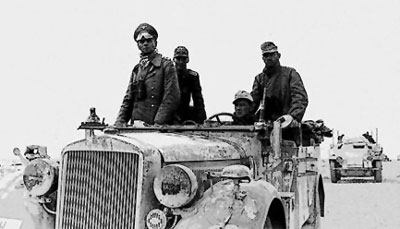 |
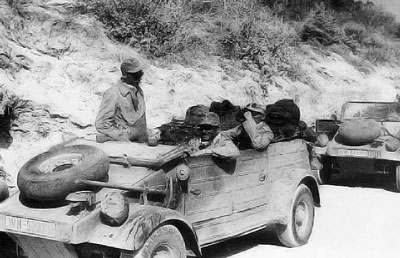 |
Over the next several weeks, von Luck became acclimated with desert conditions as well as his troops. Finally, on 26 May, Operation Venezia began. The battalion travelled through the night toward their objective, which was the coastal road east of Tobruk. The goal was to block the coast road and secure the flank of the Africa Corps. It wasn’t long into 27 May when the division came under attack from newly arrived Grant tanks, most likely with the 3rd Royal Tank Regiment. Suddenly spotted by the Grants, the battalion came under heavy fire.
Von Luck ran from his vehicle toward the Pak38 anti-tank guns, in order to coordinate a defence.
|
|
Amid the shelling, he was blasted to the ground with a severe leg
injury. Largely sustained by morphine, von Luck still retained command
for the next five days, issuing orders from the back of a Kubelwagen.
Finally, after five days, medical orderlies ordered von Luck back to Derna as the wound became infected. From Derna, he travelled via hospital ship on to Germany for several months of recovery.
|
|
Here he got a chance to meet other wounded men returning from Russia as well as witness the air war and its effects on German cities. It was not until August that he was finally released as fit for limited combat duty. He immediately flew back to Derna and was once again on African soil.
By chance, von Luck again arrived mere weeks before another offensive, this time at the El Alamein position just outside the Egyptian border. The Africa Corps had tried several days prior to
crack the position, but failed miserably.
|
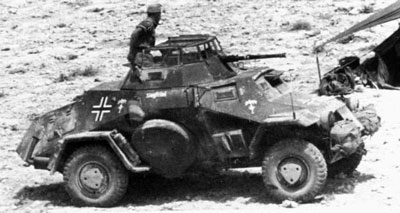 |
|
Upon meeting with Rommel and
Gause to be brought up to speed, they both indicated that a lack of
supplies and British RAF air superiority sealed the fate of the
assault. At this point in early September, there was a lull in the
front lines, as both sides consolidated positions and gathered
reinforcements.
Von Luck travelled via plane to the Siwa oasis, on the southern tip of the German lines. Here his 3rd Panzer Reconnaissance Battalion was again charged with flank security. While the battle at El Alamein is considered a main event in the desert war, the recon battalion actually took no major part in the battle, as it was so far removed to the south. Once the Commonwealth troops punctured the Axis lines and the retreat began, the battalion’s job of flank security bore more importance.
|
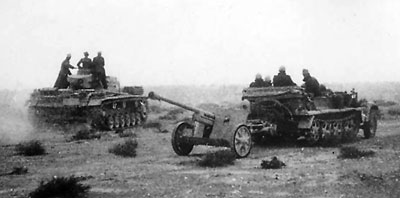 |
Montgomery continued to utilize his now superior RAF to harass the Axis forces retreated west along to costal highway and use his armour in a hook to the south to cut them off. Rommel remained one step ahead, and eventually led his broken army back to Tunisia to join von Arnim and his new arrived Fifth Panzer Army.
Upon arriving in Tunisia, Rommel’s army secured new positions, and von Lucks battalion was charged with defending the area south of Homs and Tripoli.
|
|
Von Luck had another meeting with Rommel on New
Years Eve, 1942. Rommel was concerned that the Americans, with vast
amounts of resources and fresh troops, posed a bigger threat in the
west. He moved the remainder of the 21. Panzerdivision to southern
Tunisia to rest in anticipation of an American move from the Atlas
Mountains. Rommel gave him command of two additional battalions of
reconnaissance troops to stiffen resistance. In late January von Lucks new recon group was ordered to assault and
capture the French fort of Foum Tataouine. Designed to be a quick
strike, the recon forces were sent to sack the fort and return to the
safety of their lines.
Halfway to the fort however, Allied air supremacy became painfully apparent. British Hurricanes found the Axis troops and commenced attack, and on the first run destroyed the anti-aircraft platoon before it could fire a shot. The second run saw the destruction of an anti-tank platoon. Nearly helpless, the Axis troops radioed for air support, which finally showed up over an hour later after several vehicles were shot up. Although the fort was taken without incident, Allied supremacy in Africa was now becoming apparent.
|
|
Upon returning to Axis lines and a debriefing with General Gause, von Luck became aware of the next offensive, this time aimed at the newly arrived Americans. Rommel considered the operation promising due to the lack of experience of the American forces. It was to be conducted by the 10. and 21. Panzer divisions and assorted Axis support units.
The 21. Panzerdivision attacked American positions in the Faid pass on 1 February 1943. The Axis took the pass and 1,000 American POW’s. After a week or two of rest, the same panzer
division turned north, and dealt a blow to the US 2nd Armored Division,
taking the town of Gafsa, 1,600 prisoners, and destroying 150 tanks.
|
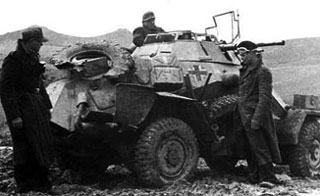 |
|
In the wake of the assault, von Luck’s recon battalion was rushed forward to take the Kasserine pass and hold it open for advancing Axis units. This was the first time he met American military units, and it made a lasting impression on him. The American troops, although largely inexperienced, were amply equipped and supplied. He would find out later in Italy and France that the Americans had overcome their inexperience and become an effective fighting force.
The thrust north came to a standstill with the Axis withdrawing back to the Kasserine Pass. In the beginning of March von Luck had his final meeting with Rommel in Africa who flew back to Germany for a staff meeting with Hitler. Colonel-General von Arnim took control of Army Group Africa. At the end of the month he sent for von Luck, who was also scheduled to be sent back to Germany. In its death throes, Army Group Africa was being left to die by the high command. Rommel’s final appeals did nothing to change the fact. In desperation, von Luck was chosen to fly to Fuhrer headquarters to lay before Hitler a plan for evacuation.
|
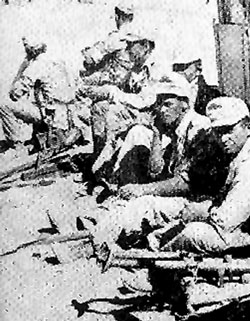 |
Thus began the long journey back home, to several meetings with senior officers and Hitler himself. Along the way, von Luck made his report to Field Marshall Kesselring, Colonel-General Guderian (now chief of staff), and finally a meeting with Colonel General Jodl. After making his impassioned speech, Jodl denied him access to the Fuhrer, perhaps knowing the outcome. Even after the disaster at Stalingrad, Hitler refused to consolidate ground in order to save his ground troops. In the case of the Sixth Army, and now with Army Group Africa, the Axis troops were left to their own fate with no help from higher command.
Despite efforts to return to his men, von Luck wasn’t able to make it in time before the final collapse. The African chapter of the war now at a close, and von Luck remained eager for his next assignment. It wouldn’t be until August he would be assigned to Paris, to the Panzer Reconnaissance School. Effectively the mid-war period was over for von Luck. He had seen much, travelling thousands of miles, fought many battles, and met with some of the most powerful men in the German armed forces.
|
|
Within the next year, he would take his experiences in the desert and use it to hone the fighting skill of his new recruits, in order to prepare for the battle everyone knew was coming: a cross-channel invasion and the Allied attempt to gain a foothold on the European continent.
Hans von Luck in Flames Of War
To field Hans von Luck in Late-war see Monty's Meatgrinder.
|
 |
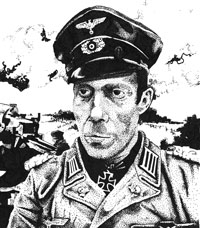 |
Mid-war Characteristics
Major Hans von Luck is a Warrior and a Higher Command SMG team with a Kübelwagen for transport. He is rated as Confident Veteran.
Von Luck may join a Panzerspähkompnie from the 21. Panzerdivision (North Africa pages 32 to 35) for 55 points.
Von Luck may be mounted in a Sd Kfz 222 armoured car instead of being an SMG team for an additional +35 points. If he does this he is also a Reconnaissance team.
|
|
Special Rules
Get Moving: Von Luck knows the value of speed, and of caution. He’s always on the move, seeking the critical point.
Major von Luck, and any platoon he leads, may re-roll failed Skill Tests to make Stormtrooper moves.
It’s but a Flesh Wound: Even though gravely wounded, Von Luck remained in control of the battle for 5 days before being evacuated.
If von Luck is destroyed the opposing player makes a roll to see if von Luck is removed from play. Instead of using the Warrior rules on page 78 of the rulebook roll a die and consult below.
On a roll of 5+ you seriously wounded Von Luck and the team is destroyed, but you’ll be seeing him again in Normandy!
Otherwise, the owning played may designate any other friendly tank or infantry team that is within Command Distance of the von Luck to become his new Warrior team.
Reconnaissance Expert: Von Luck is a reconnaissance man.
Unless he has joined a platoon that is not a Reconnaissance Platoon, von Luck may Disengage as if he were a Recce team. Because of his experience, he is never Forced to Disengage (See pages 150 and 151 of the rulebook) even if the platoon he has joined has Disengaged.
|
Last Updated On Friday, May 28, 2010 by Wayne at Battlefront
|
|
|